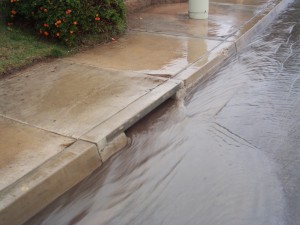By Garry Brown, Executive Director / Orange County Coastkeeper
As summer weather has finally come to a close, it is time to start preparing for the wet season. The day after a rain storm is clear, crisp, and there is a sense of renewal in the air. All the streets appear clean, but while short-lived, rain events in Southern California have profound impacts on local water quality.
Materials that have accumulated on streets and drainage systems over the course of the dry season, in this case about seven months, are washed away through the drains and into the ocean.
 The so called “first flush” carries urban runoff including oil, pesticides, fecal matter, bacteria, and various other pollutants down untreated storm drains and channels where it mixes with coastal waters and onto our beaches.
The so called “first flush” carries urban runoff including oil, pesticides, fecal matter, bacteria, and various other pollutants down untreated storm drains and channels where it mixes with coastal waters and onto our beaches.
Rainfall totaling to a just a quarter inch is enough to propagate the first flush. Coastal counties advise staying out of the water for three days following a rain event. However, a study of storm water runoff conducted by Heal the Bay and UCLA suggests that three days is not a sufficient amount of time, and the rule should be increased to 5-10 days.
Let me put this first flush into a larger perspective.
The Santa Ana River Watershed begins in the San Bernardino Mountains, travels through San Bernardino, Riverside and Orange Counties and drains at Huntington and Newport Beach. We are at the end of a nearly 3,000 square mile funnel with 4.5 million residents.
In my August Going Green column, I discussed how the City of Newport Beach has done a great job of preventing debris from entering our precious waterways, and touched just a little bit about the ongoing issues of urban runoff. While Newport Beach is doing what it can to protect water quality, there is not much they can do about everyone upstream.
There are things that residents and businesses can do to prevent pollution from urban runoff. Research estimates that 80 percent of marine debris comes from land, so one the easiest ways to prevent this kind of pollution from reaching our shores is to pick up litter and use reusable bags, water bottles, and containers.
At Coastkeeper’s monthly beach cleanups, one of the most common pollution items we see on the beach is Styrofoam, so make sure your take-out containers make it into a garbage can.
We also encourage businesses and homeowners to consider California Friendly landscaping, which uses fewer pesticides and fertilizers and utilizes natural systems that prevent runoff from escaping properties. Learn more at coastkeeper.org/coastkeeper-garden.
Regardless of it being the wet or dry season, we want to remind every ocean lover to play it safe and avoid coastal waters impacted by discharging storm drains, creeks and rivers.
Information regarding such conditions can be found through the county’s Ocean Water Protection Program at ocbeachinfo.com, or if you frequent beaches outside of the OC, you can download the free Swim Guide app (Green theswimguide.org) for beach water quality info along the West Coast and throughout the US.




